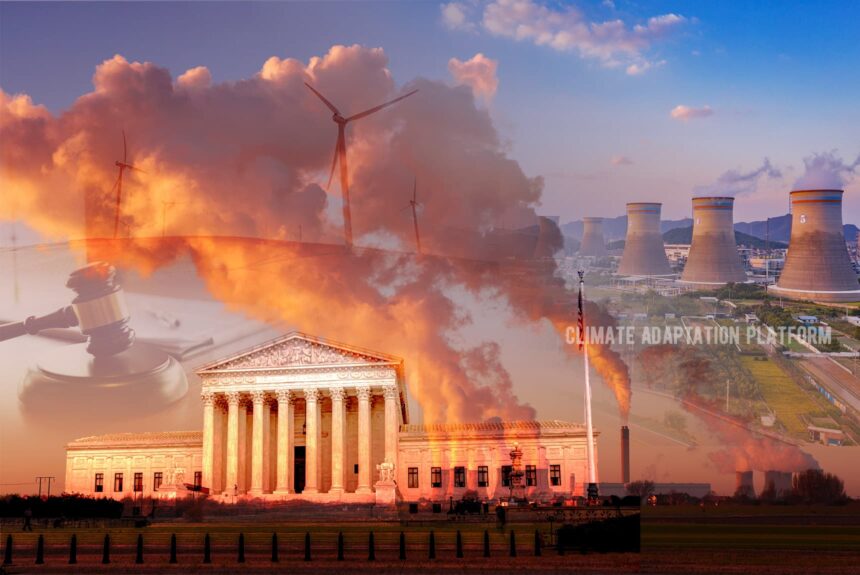On 30 June, the US Supreme court, with its 6-3 votes, ruled in favour of West Virginia vs the Environmental Protection Agency (EPA), saying that the EPA had overstepped its authority to enforce the Clean Air Act by limiting power plant emissions.
The Clean Air Act, the majority ruled, does not permit the agency to reshape the power grid by relying more heavily on cleaner sources like solar and wind power. Instead, when setting guidelines for existing power plants, the EPA must rely only on technological solutions that do not require fundamental changes to these power plants, which means that a coal-fired plant must be allowed to remain as one and not required to add or change to renewable sources, the SC ruling explains.
The Economist article, “The Supreme Court throttles Joe Biden’s climate agenda”, says that the court’s decision, aside from sharply limiting the EPA’s power to regulate the millions of tonnes of greenhouse gases discharged by coal-burning power plants each year, will also have far-reaching consequences for the government’s ability to curb the greenhouse-gas emissions that are heating the planet.
By ruling in favour of the coal producers, the Supreme court has restricted Mr Biden’s ability to decarbonise the American power sector, which is responsible for 25% of the country’s emissions and the second largest after transport (The Supreme Court throttles, 2022).
The Supreme Court throttles (2022) further explained:
“In his majority opinion, joined by all five of his conservative colleagues, Chief Justice John Roberts described the Clean Power Plan, the Obama-era regulatory regime at issue, as an “unheralded” scheme affecting “a significant portion of the American economy”. Reducing carbon dioxide emissions and forcing “a nationwide transition away from the use of coal to generate electricity”, he wrote, “may be a sensible ‘solution to the crisis of the day”, but “it is not plausible that Congress gave EPA the authority to adopt on its own such a regulatory scheme”.
“The Clean Air Act may empower the EPA to regulate greenhouse-gas emissions, Chief Justice Roberts wrote, but “separation of powers principles and a practical understanding of legislative intent” require “clear congressional authorisation” before systemic regulations affecting the entire power network can be drawn up.”
The New York Times opinion piece says that the supreme court’s decision is part of the broader campaign by conservatives to wage war on environmental regulations. In response, the three members of the court’s liberal minority write that the majority’s decision strips the EPA of the power “to respond to the most pressing environmental challenge of our time” (The Supreme Court Sabotages, 2022).
Below are more excerpts from the article:
- Although the court did not contest the agency’s legal authority to set acceptable standards for emissions and impose restrictions on emitters, it says that the Clean Air Act does not provide the agency to achieve those emissions standards. Constraining EPA’s power to regulate the Supreme Court “effectively prevents good decisions from being made”.
- It argues that Congress has already decided that regulatory agencies staffed by experts are the “best available mechanism for a representative democracy to make decisions in areas of technical complexity” and the “entity that Congress relies upon to figure out how clean the air should be, and how to get there. Asserting that it lacks the power to perform its basic responsibilities is sabotage.”
- The ruling will make it harder for Mr Biden to decarbonise the American power sector, responsible for 25% of the country’s emissions, by 2035, writes Catherine Brahic, The Economist’s Environmental Editor, on 11 July 2022, The Climate Issue.
- She says the West Virginia v EPA was drawn up as an objection to Obama’s Clean Power Plan, which aimed to cut powerplant emissions to a third below 2005 levels by 2030. Although the plan was never executed, the US’s remarkable growth in renewable energy allowed it to achieve remissions reduction by 2019.
- Despite the supreme court’s ruling, the EPA retains its authority to regulate other forms of pollution from coal-fired power stations with the same net result as regulating carbon emissions. It can, for example, strengthen rules on mercury pollution and limit nitrogen oxides which react to form ground-level ozone, a harmful chemical component of smog. Brahic notes that although these are all powerful options, it feels like tinkering around the edges instead of dealing with the heart of the problem.
Click the sources links below to know more about the US Supreme Court ruling and its implication for climate action.
Sources:
The Supreme Court throttles Joe Biden’s climate agenda. (2022, June 30). The Economist. Retrieved from https://www.economist.com/united-states/2022/06/30/the-supreme-court-throttles-joe-bidens-climate-agenda
The Supreme Court Sabotages Efforts to Protect Public Health and Safety. (2022 July 1). The New York Times. Retrieved from https://www.nytimes.com/2022/07/01/opinion/supreme-court-epa-ruling.html



Leave a Reply